

Trifluoromethyl sulphur pentafluoride. Trifluoromethyl sulphur pentafluoride, CF3SF5, is a rare industrial greenhouse gas,[1] first published in 2000[2] by a group of researchers from Germany, the United Kingdom and the United States.[3] Trifluoromethyl sulphur pentafluoride is considered to be one of the several super greenhouse gases.

On a per molecule basis, it is considered to be the most potent greenhouse gas present in Earth’s atmosphere.[4] However, the current concentration of Trifluoromethyl sulphur pentafluoride remains at a level that is unlikely to measurably contribute to earth's warming.[4] The source of the gas is attributed to anthropogenic sources, possibly a by-product of the manufacture of fluorochemicals, originating from reactions of SF6 with fluoropolymers used in electronic devices and in microchips, or the formation can be associated with high voltage equipment created from SF6 (a breakdown product of high voltage equipment) reacting with CF3 to form the CF3SF5 molecule.[4] Fluorine azide. Fluorine azide or triazadienyl fluoride FN3 is a yellow green gas composed of nitrogen and fluorine with formula FN3.[1] It is counted as an interhalogen compound, as the azide functional group is termed a pseudohalogen.

It resembles ClN3, BrN3, IN3 in this respect.[2] The bond between the fluorine atom and the nitrogen is very weak, leading to this substance being very unstable and prone to explosion.[3] Calculations show the F—N angle to be around 102° with a straight line of 3 nitrogen atoms.[4] The gas liquifies at –82° and can be turned to a solid at –152 °C.[1][2] It was first made by John F. Hexafluoroethane. Hexafluoroethane is a fluorocarbon counterpart to the hydrocarbon ethane.

It is a non-flammable gas negligibly soluble in water and slightly soluble in alcohol. Physical properties[edit] Trimix (breathing gas) Argox. Argox is the informal name for a scuba diving breathing gas consisting of argon and oxygen.

Occasionally the term argonox has been used to mean the same mix. The blend may consist of varying fractions of argon and oxygen, depending on its intended use. The mixture is made with the same gas blending techniques used to make nitrox, except that for argox, the argon is added to the initial pure oxygen partial-fill, instead of air. Hydreliox. Hydreliox is an exotic breathing gas mixture of helium, oxygen and hydrogen.[1][2] See also[edit] References[edit] Jump up ^ Fife, WP (1979).
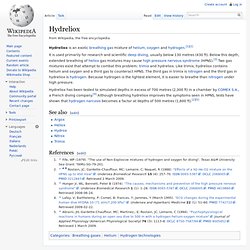
Heliox. Heliox is a breathing gas composed of a mixture of helium (He) and oxygen (O2).
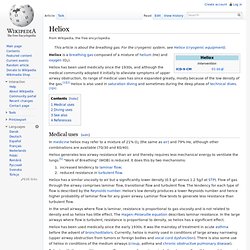
Heliox has been used medically since the 1930s, and although the medical community adopted it initially to alleviate symptoms of upper airway obstruction, its range of medical uses has since expanded greatly, mostly because of the low density of the gas.[1][2] Heliox is also used in saturation diving and sometimes during the deep phase of technical dives.[3][4] Medical uses[edit] In medicine heliox may refer to a mixture of 21% O2 (the same as air) and 79% He, although other combinations are available (70/30 and 60/40).
Heliox generates less airway resistance than air and thereby requires less mechanical energy to ventilate the lungs.[5] "Work of Breathing" (WOB) is reduced. It does this by two mechanisms: increased tendency to laminar flow;reduced resistance in turbulent flow. Heliox has a similar viscosity to air but a significantly lower density (0.5 g/l versus 1.2 5g/l at STP). Radon. Radon is a chemical element with symbol rn and atomic number 86.
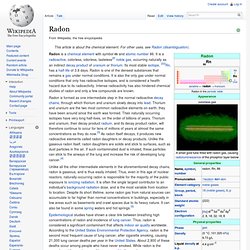
It is a radioactive, colorless, odorless, tasteless[2] noble gas, occurring naturally as an indirect decay product of uranium or thorium. Its most stable isotope, 222Rn, has a half-life of 3.8 days. Inappropriate Content. Silane. This article is about the compound with chemical formula SiH4.
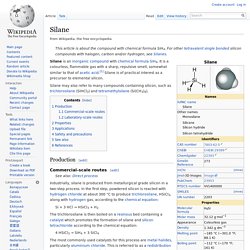
For other tetravalentsingle bonded silicon compounds with halogen, carbon and/or hydrogen, see Silanes. Silane is an inorganic compound with chemical formula SiH4. Nitrogen trifluoride. Nitrogen trifluoride is the inorganic compound with the formula NF3.
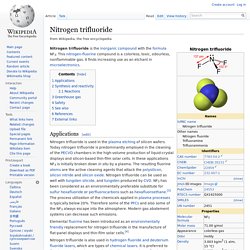
This nitrogen-fluorine compound is a colorless, toxic, odourless, nonflammable gas. It finds increasing use as an etchant in microelectronics. Fluorinated gases. Fluorinated gases (F-gases) are man-made gases that can stay in the atmosphere for centuries and contribute to a global greenhouse effect.
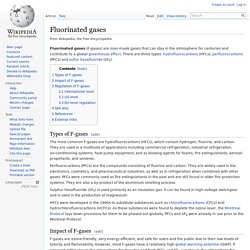
There are three types: hydrofluorocarbons (HFCs), perfluorocarbons (PFCs) and sulfur hexafluoride (SF6). Types of F-gases[edit] The most common F-gases are hydrofluorocarbons (HFCs), which contain hydrogen, fluorine, and carbon. They are used in a multitude of applications including commercial refrigeration, industrial refrigeration, air-conditioning systems, heat pump equipment, and as blowing agents for foams, fire extinguishants, aerosol propellants, and solvents. Perfluorocarbons (PFCs) are the compounds consisting of fluorine and carbon. Fumarole. Fumaroles may occur along tiny cracks or long fissures, in chaotic clusters or fields, and on the surfaces of lava flows and thick deposits of pyroclastic flows. A fumarole field is an area of thermal springs and gas vents where magma or hot igneous rocks at shallow depth are releasing gases or interacting with groundwater. From the perspective of groundwater, fumaroles could be described as a hot spring that boils off all its water before the water reaches the surface.
Fumaroles may persist for decades or centuries if they are above a persistent heat source, or disappear within weeks to months if they occur atop a fresh volcanic deposit that quickly cools. The Valley of Ten Thousand Smokes, for example, was formed during the 1912 eruption of Novarupta in Alaska. Initially, there were thousands of fumaroles in the cooling ash from the eruption, but over time most of them have become extinct. Sulfur dioxide. The specific person who discovered sulfur dioxide is not known, but it was first used by the Romans in winemaking, when they discovered that burning sulfur candles inside empty wine vessels keeps them fresh and free from vinegar smell.[2] Structure and bonding[edit] The sulfur - oxygen bond has a bond order of 1.5.
Acetylene. Acetylene (systematic name: ethyne) is the chemical compound with the formula C2H2. It is a hydrocarbon and the simplest alkyne.[3] This colorless gas is widely used as a fuel and a chemical building block. It is unstable in pure form and thus is usually handled as a solution.[4] Pure acetylene is odorless, but commercial grades usually have a marked odor due to impurities.[5] Discovery[edit] Acetylene was discovered in 1836 by Edmund Davy, who identified it as a "new carburet of hydrogen".[7] It was rediscovered in 1860 by French chemist Marcellin Berthelot, who coined the name "acetylene".
Berthelot was able to prepare this gas by passing vapours of organic compounds (methanol, ethanol, etc.) through a red-hot tube and collecting the effluent. Shale gas. As of 2013, the US, Canada, and China are the only countries producing shale gas in commercial quantities. The US and Canada are the only countries where shale gas is a significant part of the gas supply. Shale gas is natural gas that is found trapped within shale formations.[1] Shale gas has become an increasingly important source of natural gas in the United States since the start of this century, and interest has spread to potential gas shales in the rest of the world.
In 2000 shale gas provided only 1% of U.S. natural gas production; by 2010 it was over 20% and the U.S. government's Energy Information Administration predicts that by 2035, 46% of the United States' natural gas supply will come from shale gas.[2] The Obama administration believes that increased shale gas development will help reduce greenhouse gas emissions[6] (in 2012, US carbon dioxide emissions dropped to a 20-year low[7]). Breathing gas. Perfect gas. Carbon dioxide. Carbon dioxide (chemical formula CO2) is a naturally occurring chemical compound composed of 2 oxygen atoms each covalently double bonded to a single carbon atom. Argon. Natural gas. Natural gas is a fossil fuel formed when layers of buried plants, gases, and animals are exposed to intense heat and pressure over thousands of years. The energy that the plants originally obtained from the sun is stored in the form of chemical bonds in natural gas. Ethylene. Ethylene (IUPAC name: ethene) is a hydrocarbon with the formula C 2H 4 or H2C=CH2.
Helium. Xenon. Hydrogen. Hydrogen gas was first artificially produced in the early 16th century, via the mixing of metals with acids. In 1766–81, Henry Cavendish was the first to recognize that hydrogen gas was a discrete substance,[8] and that it produces water when burned, a property which later gave it its name: in Greek, hydrogen means "water-former". Industrial production is mainly from the steam reforming of natural gas, and less often from more energy-intensive hydrogen production methods like the electrolysis of water.[9] Most hydrogen is employed near its production site, with the two largest uses being fossil fuel processing (e.g., hydrocracking) and ammonia production, mostly for the fertilizer market.